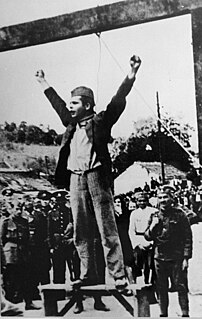
The Belgian Resistance collectively refers to the resistance movements opposed to the German occupation of Belgium during World War II. Within Belgium, resistance was fragmented between many separate organizations, divided by region and political stances. The resistance included both men and women from both Walloon and Flemish parts of the country. Aside from sabotage of military infrastructure in the country and assassinations of collaborators, these groups also published large numbers of underground newspapers, gathered intelligence and maintained various escape networks that helped Allied airmen trapped behind enemy lines escape from German-occupied Europe.
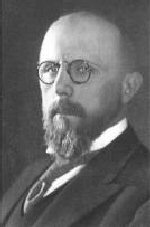
Alexandre Galopin was a Belgian businessman notable for his role in German-occupied Belgium during World War II. Galopin was director of the Société Générale de Belgique, a major Belgian company, and chairman of the board of the motor and armaments company Fabrique Nationale d'Armes de Guerre (FN). At the head of a group of Belgian industrialists and financiers, he gave his name to the "Galopin Doctrine" which prescribed how Belgian industry should deal with the moral and economic choices imposed by the occupation. In February 1944, he was assassinated by Flemish collaborators from the DeVlag group.
Robert Herman Alfred de Foy was a Belgian magistrate, and head of the Belgian State Security Service, during the occupation of Belgium by the Nazis. This period of his life has led to considerable historical debate around de Foy's legacy, but in the post-war period he returned to his pre-war position, was decorated Grand Officer of the Order of Leopold II, and recognised as "Righteous Among the Nations" by the state of Israel.

The Resistance Medal 1940–1945 was a Belgian war medal established by royal decree of the Regent on 16 February 1946 and awarded to all members of the Belgian armed resistance during the Second World War and to members of the intelligence service who operated in occupied territories and participated in combat actions aimed at the liberation of Belgium.

The Military Administration in Belgium and Northern France was an interim occupation authority established during the Second World War by Nazi Germany that included present-day Belgium and the French departments of Nord and Pas-de-Calais. The administration was also responsible for governing the zone interdite, a narrow strip of territory running along the French northern and eastern borders. It remained in existence until July 1944. Plans to transfer Belgium from the military administration to a civilian administration were promoted by the SS, and Hitler had been ready to do so until Autumn 1942, when he put off the plans for what was intended to be temporary but ended up being permanent until the end of German occupation. The SS had suggested either Josef Terboven or Ernst Kaltenbrunner as the Reich Commissioner of the civilian administration.
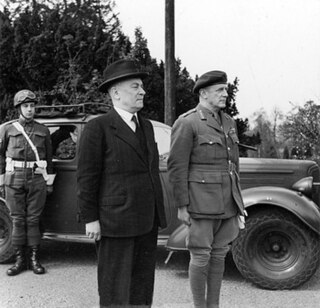
The Belgian government in London, also known as the Pierlot IV Government, was the government in exile of Belgium between October 1940 and September 1944 during World War II. The government was tripartite, involving ministers from the Catholic, Liberal and Labour Parties. After the invasion of Belgium by Nazi Germany in May 1940, the Belgian government, under Prime Minister Hubert Pierlot, fled first to Bordeaux in France and then to London, where it established itself as the only legitimate representation of Belgium to the Allies.

The Royal Question was a major political crisis in Belgium that lasted from 1945 to 1951, coming to a head between March and August 1950. The "question" at stake surrounded whether King Leopold III could return to the country and resume his constitutional role amid allegations that his actions during World War II had been contrary to the provisions of the Belgian Constitution. It was eventually resolved by the abdication of Leopold in favour of his son Baudouin in 1951.
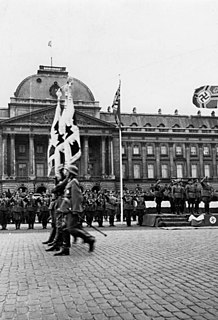
Despite being neutral at the start of World War II, Belgium and its colonial possessions found themselves at war after the country was invaded by German forces on 10 May 1940. After 18 days of fighting in which Belgian forces were pushed back into a small pocket in the north-west of the country, the Belgian military surrendered to the Germans, beginning an occupation that would endure until 1944. The surrender of 28 May was ordered by King Leopold III without the consultation of his government and sparked a political crisis after the war. Despite the capitulation, many Belgians managed to escape to the United Kingdom where they formed a government and army-in-exile on the Allied side.

The Secret Army was a faction within the Belgian Resistance active during the German occupation of Belgium during World War II. Founded in August 1940 as the Belgian Legion, the Secret Army changed its name on a number of occasions during its existence, adopting its final appellation in June 1944. It was the largest resistance group active in the country.
The Armed Partisans was a faction of the resistance in German-occupied Belgium in World War II. The group was affiliated to the Belgian Communist Party. In 1941, many of its members left to join the Front de l'Independance while the rest of the group was undermined in 1943 when almost all the leadership of the group and the Communist Party were arrested by German forces. It was renamed the Belgian Army of Partisans' after the Liberation of Belgium in September 1944.
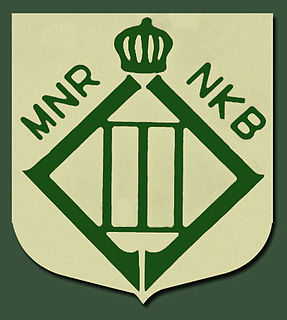
The National Royalist Movement was a group within the Belgian Resistance in German-occupied Belgium during World War II. It was active chiefly in Brussels and Flanders and was the most politically right-wing of the major Belgian resistance groups.
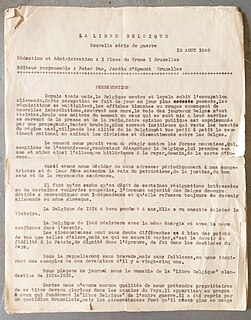
During World War II, La Libre Belgique was one of the most notable underground newspapers published in German-occupied Belgium. This was partly a result of the success of a newspaper with the same title that had been produced in German-occupied Belgium during World War I. Though a number of editions appeared in 1940 and 1941, the most enduring La Libre Belgique published during the World War II was the so-called "Peter Pan" edition which ran to 85 issues with a circulation of 10,000 to 30,000 each.

Radio Belgique (French) and Radio België (Dutch) were radio broadcasts transmitted to German-occupied Belgium from London during World War II. It was produced with the support of the Belgian government in exile and formed part of the BBC's European Service.
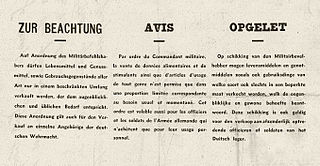
The Committee of Secretaries-General was a committee of senior civil servants and technocrats in German-occupied Belgium during World War II. It was formed shortly before the occupation to oversee the continued functioning of the civil service and state bureaucracy independently of the German military occupation administration.

The German occupation of Belgium during World War II began on 28 May 1940, when the Belgian army surrendered to German forces, and lasted until Belgium's liberation by the Western Allies between September 1944 and February 1945. It was the second time in less than thirty years that Germany had occupied Belgium.
The Belgian economic miracle was a period of rapid economic growth in Belgium after World War II, principally between 1945 and 1948. It was characterised by parallel trends of rising employment and real wages and low inflation, leading to improvements in living standards. It formed part of the period of rapid post-war economic expansion in Western Europe in the late 1940s and 1950s but preceded many other "economic miracles" and was notably shorter in duration. The term itself has been criticised in relation to its possible contribution to the growing obsolescence of Belgian heavy industry in the 1950s and 1960s and emergence of deindustrialisation.
On 13 January 1959, King Baudouin addressed the nation by radio and declared that Belgium would work towards the full independence of the Belgian Congo.
Geneviève Janssen-Pevtschin, also known Ginette Pevtschin, was a Belgian lawyer and the first woman magistrate in Belgium. She also was a distinguished member of the Belgian Resistance during World War II.
Louise van den Plas was a Belgian suffragist and the founder of the first Christian feminist movement in Belgium.
Anarchism in Belgium began to spread after the fall of the Paris Commune, when many Communards, including Élisée Reclus, took refuge in Brussels. At the time, the Belgian César de Paepe defended a mutualism inspired by Pierre-Joseph Proudhon, which proposed to organize production and distribution by relying on independent workers' associations without the intermediary of the State.













